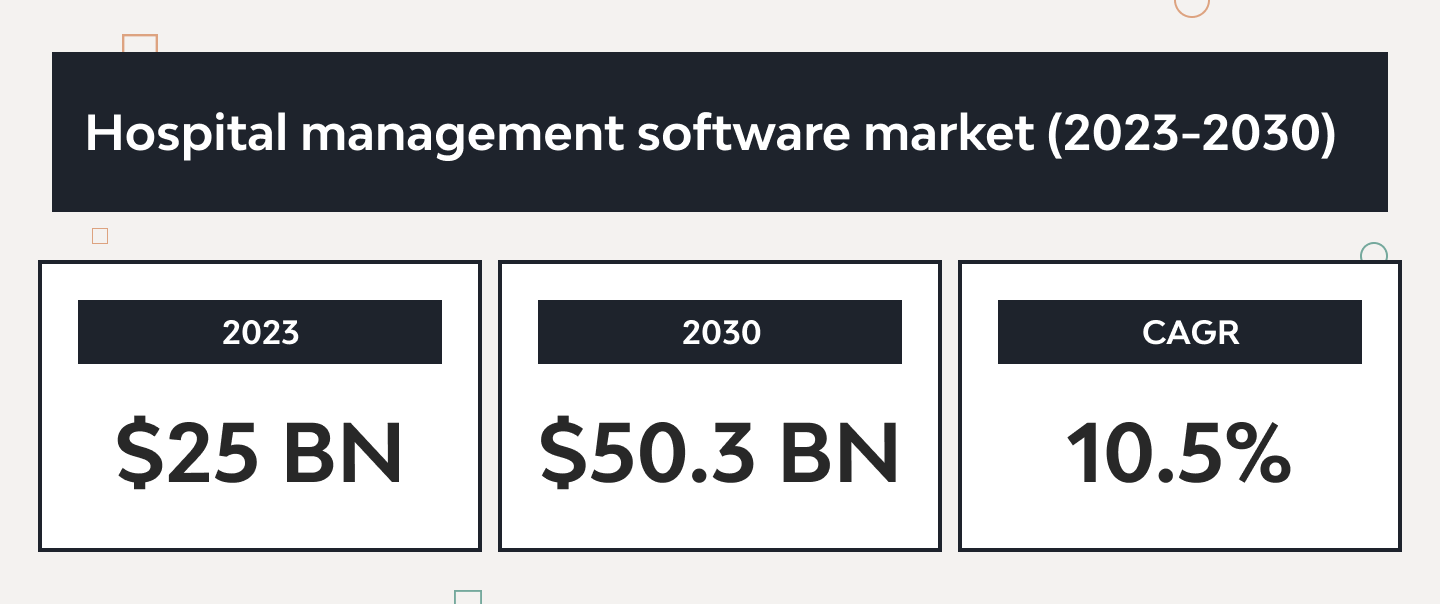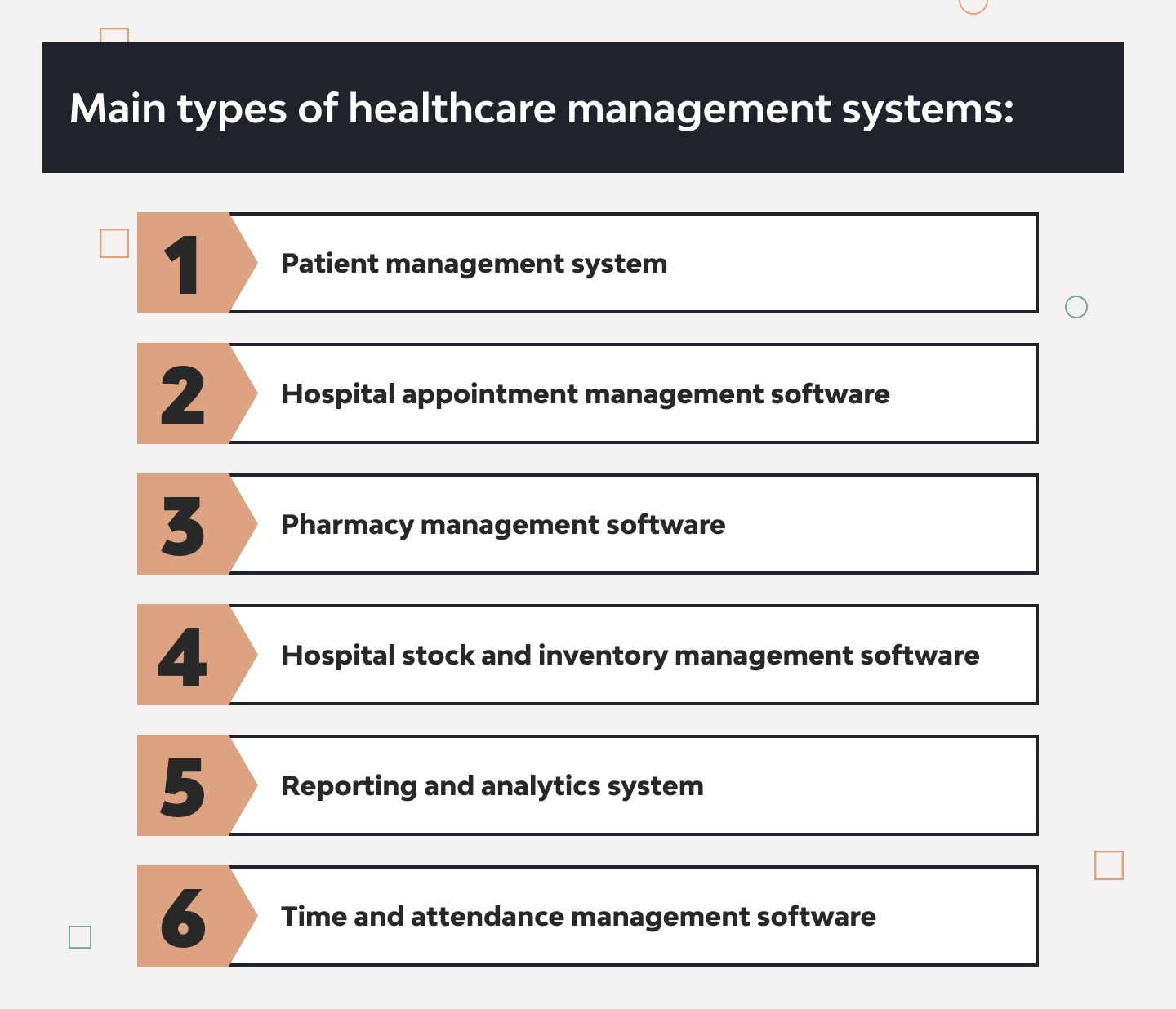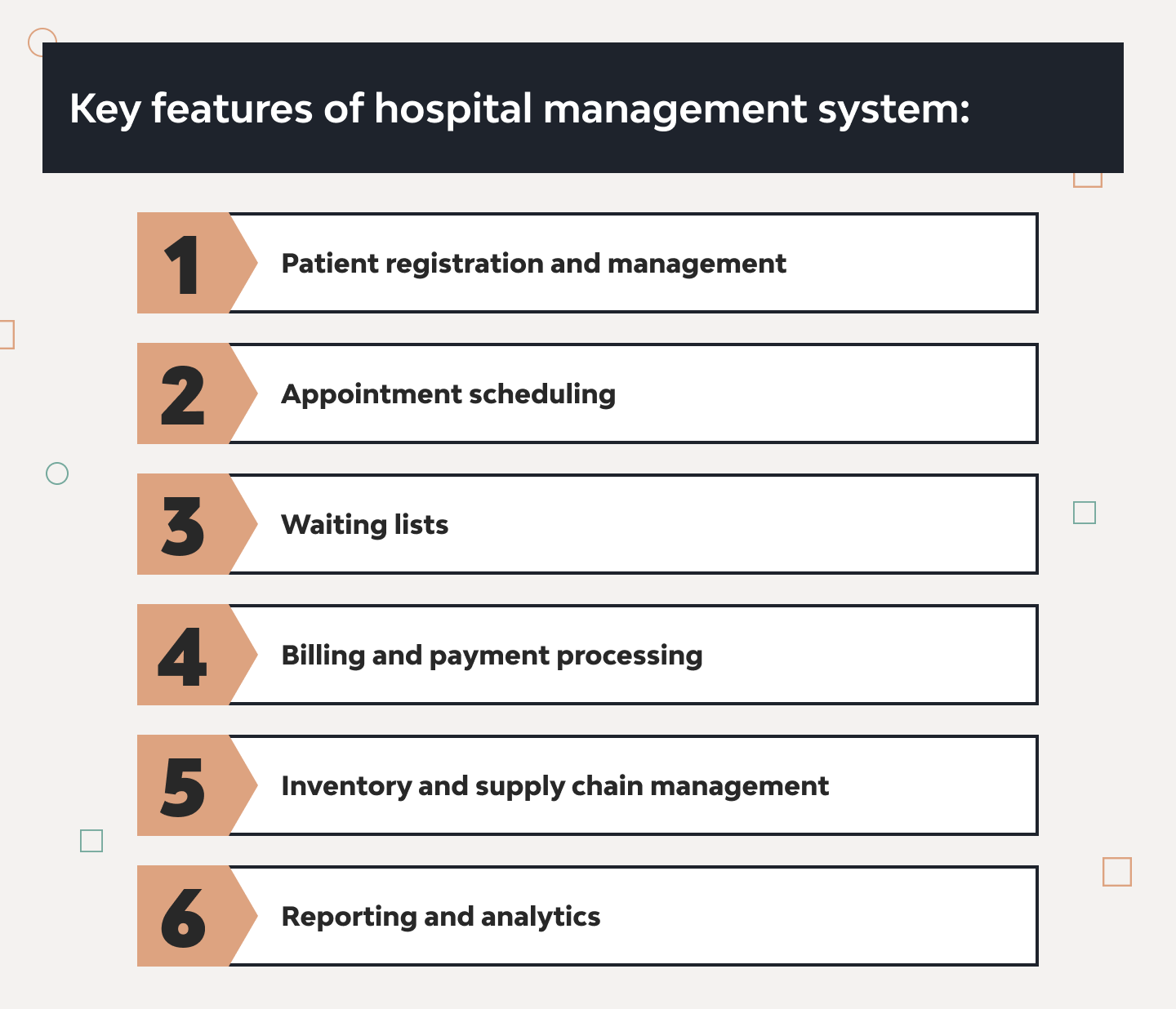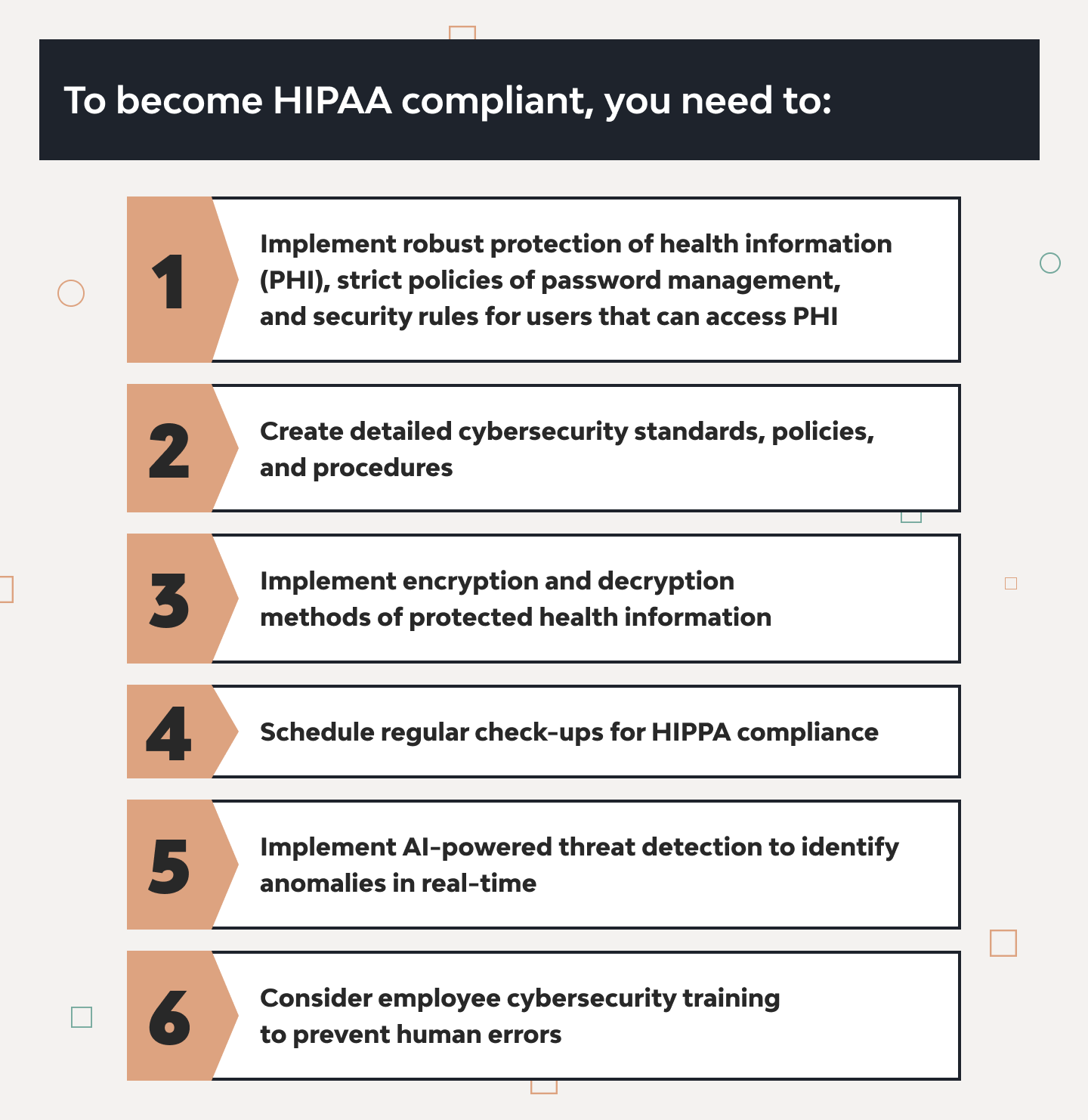A Step-by-Step Guide to Hospital Management Software Development: Features, Integrations, and Process

Nowadays, hospitals and medical institutions are going digital to improve their efficiency, personalize patient care, and automate administrative processes. A Hospital Management System (HMS) is one of the ways to improve the healthcare process by automating tasks such as patient management, billing, scheduling, and inventory control.
In this blog post, you’ll learn how to create hospital management software, its key features, compliance regulations, integration with legacy systems, and estimated costs. Whether you’re a healthcare provider or a tech entrepreneur, this article will give you all the knowledge for hospital management software development. Let’s begin.
What is Hospital Management Software?
Hospital management software is a platform for storing and managing hospital data and operations and sharing them across various departments. Depending on the type of software, these data may include patient records, appointments, billing, inventory management, or hospital statistics and reports.
The main goal of hospital software development is to simplify administrative, financial, and healthcare operations, automate everyday tasks, reduce operational errors, and improve patient care.
According to Deloitte survey, healthcare executives put growth strategies as their top priority for 2025. To achieve this, they plan to incorporate new digital tools and technology platforms (such as patient portal tools, virtual booking platforms, or symptom triage tools) into their workflow to acquire new clients and boost the loyalty of existing ones.
Also, 53% of respondents stated that they plan to invest in new technologies, such as generative AI and digital twins, in order to enhance the productivity of their workers and decrease spending by automating manual tasks.
These statistics prove the demand for virtual health solutions and digital technologies as one of the ways to remain resilient and competitive in the market.
Let’s review the main types of hospital management systems that work best for this purpose.
Main types of healthcare management systems
How do you create hospital management software? First of all, there is no one-size-fits-all when it comes to hospital management systems. Such systems may focus on one specific task (for example, appointment management) or combine various features under one platform.
When it comes to the mode of delivery, web and cloud-based segment dominates the market, getting over 62% of the revenue share in 2023. Cloud solutions are more popular as they are easily accessible by the hospital staff and let them communicate and collaborate in real-time. However, on-premise software is also expected to grow in popularity until 2030, as it provides more control over medical data and uninterrupted access.
Let’s review the most popular types of hospital management software to better understand market demand and build a hospital management system that meets user needs.
Patient management system
Patient management software automates admissions by documenting all customer information, managing rooms, assigning beds, capturing payments, and generating bills. It helps to admit and discharge patients more quickly and efficiently and eliminates excessive paperwork.
Hospital appointment management software
Hospital appointment management software integrates appointments from various channels (such as phone, social media, website, and front desk) into a single calendar. Doctors can customize their booking preferences, control the slots, and easily manage patient flow. Such software should also be integrated with Electronic Medical Records to keep the patient’s history in one place.
Pharmacy management software
Pharmacy management software manages stocks and automatically alerts labs about the inventory levels, creates tax bills, manages returns, and sends prescriptions from pharmacies directly to ERM.
Hospital stock and inventory management software
This is a supply chain management platform for tracking medical equipment and supplies, tracking and updating the stock, auto-reordering, and managing inventory from various locations in one place.
Reporting and analytics system
According to Grandview research, the reporting and analytics segment is projected to grow at the fastest CAGR. Reporting and analytics software collects patient’s medical data to provide clinicians with granular reports on trends and patterns in treatments, drugs, and diagnoses. In addition, it can track patient records, visit statistics, treatment history, and outpatient and inpatient status, as well as provide financial reports.
Time and attendance management software
In 2023, time and attendance management software gained the largest revenue share. It enables healthcare organizations to track employee arrival and departure time, work hours, and workload to improve payroll processing, productivity, and regulatory compliance.
Benefits of custom hospital management software
When the number of patients is increasing, together with the demand for personalized service, it’s becoming challenging to stay afloat without automating manual processes. That’s when hospital management software comes to help. Let’s review the main benefits of hospital management software.
Improved Efficiency
Hospital workflow automation software puts a lot of hospital operations on autopilot, eliminates paperwork, and provides detailed analytics for improving the workflow of healthcare organizations. Also, hospitals that have all the patient data at their fingertips provide better customer service and make data-driven decisions, which makes them more efficient and resilient.
Enhanced Patient Care
With the help of such features as online appointment booking, telemedicine, feedback tools, and a patient portal with all the medical records and treatment recommendations, hospitals increase their customer loyalty and enhance patient care. Also, hospitals can segment patients into various groups according to their medical history, symptoms, preferences, and behavioral patterns to provide a more personalized service.
Cost Savings
Healthcare software that has stock and inventory management options helps healthcare providers better manage their resources and predict understock. Also, some types of hospital management software have built-in analytics that provide clinics with detailed financial reports, the performance of various departments, and recommendations on how to better manage expenses.
Better Decision Making
Hospitals that own and analyze their data make more rational decisions and improve their processes based on accurate analytics, not on intuition. Also, with hospital management software, all the staff members have access to the necessary data, which helps to eliminate team silos, operate as a unit, make better decisions, and improve healthcare policies.
Streamlined Communication
With the help of hospital management software, patients can easily communicate with doctors via an online portal and get immediate treatment without having to wait in queues. The same when it comes to the hospital staff: they can easily share patient medical records between various departments to streamline communication and eliminate human errors.
Key features of hospital management system
Now let’s review the most common hospital management software features.
Patient registration and management
A patient management system is a central hub for storing patient medical records, history, consultations, treatments, and reports. With the help of this feature, hospitals can easily register new members and search for patients using various filters.
Appointment scheduling
This feature should allow for easy and quick scheduling of patients via various appointment channels into one system. The doctors should be able to access all the appointments through a single system, manage their availability, reschedule sessions, and add people to the waiting lists. Integration with the calendar is essential here to book follow-up appointments, send reminders to doctors and patients, and set recurring events.
Waiting lists
A waiting list helps hospital staff prioritize visitors and decrease waiting times. The patient profile should be linked to their doctor in order to quickly schedule a time when the doctor has a free spot.
Billing and payment processing
In order to provide easy billing and payment processing, invoices and receipts should be automatically generated from patient records. With the help of billing and payment processing, hospitals should be able to track all their financial operations, set up rates, generate bills, collect payments, and issue printed bills and receipts.
Inventory and supply chain management
With the help of this feature, doctors, hospitals, and clinics can track the available stock, generate reports, get real-time notifications about low levels, and even request inventory online.
Reporting and analytics
The reporting and analytics section should provide detailed statistics on the number of patients, their frequency of visits, and financial operations and inventory.
Step-by-Step Process for Building Hospital Management Software
Now that you know the hospital software functionality, let’s review important steps to take in order to build a hospital management system.
Step 1: Define objectives and user needs
To create a product that meets user needs, you need to understand the main types of users and their expectations from your platform. A hospital management software typically serves the following types of users: admin, doctor, and patient. Depending on the type of software you develop, these users will have different objectives and needs. But usually, there are common features you have to include.
Admin
The admin’s role is to monitor the system’s performance, control its security, provide technical maintenance, and adapt the software functionality to hospital requirements.
Doctor
Doctors should be able to manage their schedule, set appointments, access patient profiles and their medical records, and prescribe treatment online.
Patient
When it comes to patients, their main objective is to receive personalized care based on their needs, preferences, and medical history. Patients want to quickly schedule their visits, access their medical records and treatment history online, and communicate with their doctor without waiting in queues.
Step 2: Research compliance and legal requirements (e.g., HIPAA, GDPR)
According to Grandview research, the impact of regulations on the healthcare market will grow to ensure that medical services are secure and efficient. That’s why if you want to enter the healthcare market, you need to consider the policies of HIPAA (Health Insurance Portability and Accountability Act) to protect sensitive patient medical records in the U.S. healthcare system.
Make sure to research HIPPA rules in the market you are entering, as the penalties for HIPAA violations range from $1oo41 to 1,5 million$2,134,831 per violation, depending on the level of responsibility for a fault.
Step 3: Identify features to include
Depending on the user needs and objectives, create a list of core features your platform should include. Remember not to overload the healthcare management system with a variety of features but to pick the most necessary first.
Create an MVE (Minimum Valuable Experience), which is not about what’s viable (as in MVP), but what’s valuable. MVE is all about knowing your audience, their triggers, touchpoints, and true desires. Its framework consists of 3 main components: audience, communication, and touchpoints.
- Audience
Analyze the behaviors of your target audience segments (in this case, doctors, hospital administration, and patients). What are the main challenges they face in their day-to-day work? How they’d like to increase their productivity?
- Communication
What are you trying to say with your solution? What is the main value you will bring?
- Touchpoints
Where can you reach your target audience? In your case, you can communicate with hospital administration, visit healthcare conferences, and find your target audience via Linkedin. Such interactions will help you better define what functionality to include to bring real value to all users segments.
Step 4: Select the right tech stack and architecture
The choice of programming languages in healthcare will depend on the type of healthcare management platform, its features, user base, and unique requirements. We recommend considering Python as it is commonly used for data analysis, machine learning, and artificial intelligence.
Python has a variety of libraries with pre-written code, which saves development time. With the help of these libraries, developers can handle and transform the data required for continuous data processing in Machine Learning (ML). Python also has a number of ML packages and tools for visualizing results and data analysis, which is the main requirement for hospital management systems.
We at Django Stars have extensive experience creating hospital management software using Python. For example, we have recently developed a medical data management platform that helps hospitals accelerate information flow between patients, doctors, and hospital admins.
Step 5: Design intuitive UI/UX for all user types
What is the value of your product if it is packed with the right features but is difficult to navigate? When planning a hospital system software design, you need to make it not only intuitive but also consider equity.
According to Deloitte, all health systems should provide equitable access, experience, and impact for all users—consumers, clinicians, and administrative staff. That’s why you need to understand their needs and expectations and revolve all your features and interface around your users to ensure broad adoption.
Step 6: Develop the software with agile methodologies
Agile methodology in medical management software development is all about a flexible approach and adaptability. The agile method will help you reduce risks as projects are developed in small sprints and implement changes on the go. We recommend this approach for products with dynamic requirements that are testing the market and need to adjust their features quickly.
Step 7: Test thoroughly for security, functionality, and usability
Testing is an integral part of software development. You need to continuously test your product, fix any bugs, and improve the interface based on user feedback. Without thorough testing, you risk creating a clumsy and not user-friendly product.
Step 8: Deploy and monitor with ongoing support and updates
Even after you’ve released your product, the development process is not over. You need to constantly monitor and support your software, release new updates, and improve the current functionality.
These are the main steps to develop hospital software, and what about challenges?
Challenges in Hospital Management Software Development
While developing a healthcare management system, you need to pay attention to a variety of regulations and compliances. Here are the main challenges you may face.
Adhering to strict compliance requirements
To adhere to compliance requirements, you have to encrypt patient data (both at rest and in transit, implement access controls, maintain audit logs and modifications, conduct regular security audits (ISO 27001 standards, ensure secure data storage & backups (offsite/cloud redundancy), and enable multi-factor authentication (MFA) for system access. You should also secure online payments, enable audit logs to track data access and modifications, and ensure secure data storage & backup mechanisms.
Integration with legacy systems
If the system involves decision support, ensure FDA approval. Store documentation to support legal and insurance claims, as well as make sure to adapt to country-specific laws (e.g., NHS standards in the UK). Also, to provide seamless access to patient medical histories, treatment plans, and test results across different systems, consider integrating with Electronic Health Records and Electronic Medical Records.
Ensuring data security and privacy
Data privacy and security are a must when it comes to healthcare management systems. Such systems store sensitive patient medical records, and it is your responsibility to ensure their safety. Keeping up with ever-evolving compliance laws is challenging because different countries have various regulations, making it complex to develop a system that is globally compliant.
Also, healthcare management systems usually have distributed access, which means they have multiple endpoints (such as web, mobile, cloud, on-premise systems, and IoT devices). In addition, such systems allow remote access by doctors, nurses, and admin staff, which increases the risk of hacking. That’s why it’s essential to protect your healthcare management system against unauthorized access across multiple platforms.
How Much Does It Cost to Develop a Custom Hospital Management System from Scratch?
The hospital management software cost depends on its features, compliance requirements, integrations, and development approach (custom-built vs. off-the-shelf solutions). Here’s an approximate breakdown of elements included in the cost.
Planning and research
- Market research & competitor analysis
- Compliance & legal consultation
- Requirement gathering & documentation
- UI/UX design & prototyping
Software development
- Patient registration & scheduling
- Electronic Health Records (EHR) module
- Billing & insurance management
- Pharmacy & inventory management
- Laboratory & radiology system
- Role-based access & security features
- Telemedicine & remote patient monitoring
- Mobile app (for patients & doctors)
Hospital Software Integration with Legacy Systems
- Integration with EHR/EMR (HL7, FHIR)
- Integration with PACS/RIS for medical imaging
- Integration with billing & insurance providers
- API development for third-party apps
Security & Compliance Implementation
- HIPAA/GDPR compliance setup
- Data encryption & secure storage
- Multi-factor authentication (MFA)
- Role-based access control (RBAC)
- Regular security audits & penetration testing
Hosting
- Cloud hosting (AWS, Azure, Google Cloud)
- On-premise server setup
Maintenance & Support
- Bug fixes & feature updates
- Server maintenance & monitoring
- Security patches & compliance updates
The total cost of hospital software depends on several key factors, including complexity, integrations, security requirements, and healthcare compliance software regulations.
What factors influence the healthcare system price?
Below is a breakdown of the most significant cost drivers of software development.
System complexity and features
If you want to create a basic HMS that includes such features as patient records, scheduling, and billing, the development cost will be lower. If you strive to create more advanced HMS with such features as EHR integration, telemedicine, or AI analytics, get ready for higher estimates.
Level of customization
Off-the-shelf software will cost less. However, you get less flexibility in terms of features and functionality. A custom-built HMS will cost more. However, it will pay off since you can adapt it to your unique needs and target market.
Compliance and security standards
Compliance with regulations requires additional security layers:
- HIPAA (USA), GDPR (EU), PIPEDA (Canada), NHS (UK)
- Data encryption (AES-256, TLS)
- Multi-factor authentication (MFA)
- Audit logs & access control
The more compliance measures you implement, the higher the cost for legal consultation, security, and audits.
Data storage
Since small clinics need limited storage, the cost will be lower. Large hospitals require high availability and redundancy, which will result in higher cost
Maintenance and support
Add costs for maintenance and support to your overall budget. It includes expenses for bug fixes, updates, and security patches, as well as user training, technical support, and compliance updates.
As you can see, the costs will vary. If you want to get an estimate, consider contacting us for a consultation to discuss your product in more detail.
Conclusion
We hope that this healthcare software development guide will help you create a competitive product. Hospital management software development requires careful planning, a deep understanding of workflows, and meeting compliance standards such as HIPAA and GDPR. A custom HMS can improve hospital efficiency, provide better patient care, and reduce costs by automating manual workflow.
While the development process has a lot of challenges, such as legacy system integration, data security, and user adoption, choosing the right tech stack, development methodology, and compliance strategy can help mitigate risks. Looking to create hospital management software? Сontact us for a tech consultation to learn more details about your case.













